- Home
- Injections
- Laser Treatments
- Specialties
Specialtiesview all
- Other Treatments
- Before After Photos
Before After Photosview all
- Contact Us
- Doctor And Staff
- About Celibre
- Blogs
You’ve read about threading for hair removal and have talked to your friends who absolutely love it. You’ve decided to try it and you’ve booked your first appointment. But before you head over to the salon, we’d like to caution you about a few things that may make you think twice about using threading as your go-to method to get rid of hair.
Many people don’t realize that there can be potential unwanted side effects with threading such as acne-like breakouts, infections and darkening of the skin. While threading has been around since ancient times, it may just not the best modern-day solution for you to get rid of your unwanted hair!
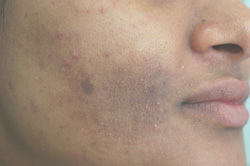
Threading is a technique in which unwanted hair (usually facial hair) is epilated (pulled out) by an intricate rolling and twisting of fine threads over the affected area. No doubt, threading leaves your skin completely smooth, but it also is extremely irritating! Often touted as “exfoliation”, the threads can damage the very top layer of skin, the epidermis, as they pull out the hair. This basically creates thousands of tiny pathways for infection-causing organisms to gain entry to your skin. Don’t think it can happen? A recent study reported multiple cases where patients developed warts after threading due to infection from HPV (human papilloma virus) transmitted this way.
Many practitioners who provide threading use their mouths to steady the threads during the procedure. That’s because they still practice threading today like practitioners in ancient times. And while that may have seemed like a good idea back then, we know now that the human mouth is dirtier than the average toilet seat!
If you are prone to acne (or even if you aren’t), the traumatic nature of threading can leave your hair follicles irritated, stimulating a breakout that looks like tiny, puss-filled pimples. Known as folliculitis, you can see an example in the picture of the woman on this page. The last thing you want to do is to trade your unwanted hair for a bigger problem—unwanted breakouts.
If you take a second look at this picture, you’ll also see an example of the unintended problem of hyperpigmentation or skin darkening that can occur after threading. This doesn’t happen to everyone after, but if you have darker skin, your pigment cells may respond to the irritation threading triggers by making more pigment, leaving you with unwanted dark patches on your skin. This young lady would have likely kept her hair or chosen another hair removal method if she had known that this is how she would look after threading!
By now, you’re probably wondering if you should just skip your threading appointment. At Celibre, we won’t dictate your choices, but we do want to ensure that you stay informed about the potential risks and unwanted side effects associated with any popular treatment. Sometimes, excessive hype can obscure the truth. A procedure such as threading for unwanted hair removal may not be the “panacea” that the media and your friends make it out to be!
Our practice doesn’t offer threading. We offer class IV medical laser treatment for unwanted hair. We do realize there are potential risks with laser hair removal as well, and we will always make it our priority to discuss these with you prior to starting treatment. Each device that we use is FDA-approved for laser hair removal and we have multiple, different devices that have been consistently shown to be both safe and effective to permanently remove your unwanted hair, no matter what your skin type (color).
Unlike threading, which hasn’t evolved much, Celibre offers only the latest and most up-to-date laser treatment. Our practitioners stay at the forefront of this growing field by maintaining the highest levels of continuing education and hands-on experience.
Have you recently had cosmetic injections of dermal fillers such as Juvederm or Restylane and are unhappy with the result? Maybe you’re happy with one side of your face, but not the other? If you’ve locked yourself away in your bedroom thinking that you’ll just have to live with your “bad filler”, think again!


Hyaluronidase is an enzyme that can be injected to dissolve fillers like Restylane, Juvederm, Lyft, Belotero, and more. It is quick, easy, and relatively painless. Best of all, hyaluronidase begins working almost immediately to dissolve the bonds between the molecules of hyaluronic acid that make up popular filler products like Restylane, Juvederm, Restylane Lyft, and Belotero. Because it only works on hyaluronic acid, hyaluronidase cannot dissolve other types of fillers like Radiesse, Sculptra, and Artefill/Bellafill.
You may need more than one injection session to completely dissolve your unwanted filler, but many people get good results after their first round of injections and many see full results within just 1 to 2 days!
Hyaluronidase goes by many different trade names: Vitrase, Wydase, Amphadase, and Hylenex are the most common. Here at Celibre Medical, we use Vitrase and find that it gives very good results for our patients. To see an example of the excellent results we’ve achieved with Vitrase, take a look at the photos on this page.
Don’t live with dermal filler that you don’t like or aren’t 100% happy with. Let us help you today get the results that you really want and will love!
You finally did it! You went and got Restylane or Juvederm injections for tiredness under your eyes that has been driving you crazy. But after a few days, you notice something that doesn’t look quite right. A bluish or greyish discoloration is visible at the point of injection. Are you seeing things? Is this normal, and if it isn’t, how can you make it go away?
Getting dermal filler injections is a big decision. It takes time and research to understand what the procedure can and can’t do for you. You must find an injector who shares your vision that also has the skills and knowledge to make it a reality. Unfortunately, this can be the hardest part. Not every injector has the same skills. And while some have the knowledge of the proper placement and techniques that are needed to perform filler injections, their technical skill may not always be up to that same level.
If you’ve noticed a bluish or greyish hue where you’ve had filler, you may be visualizing a phenomenon known as the Tyndall effect. Without getting too heavy into the physics of light, what’s happening is that light is “reflecting” off your hyaluronic acid-based filler such as Juvederm or Restylane because it’s placed too close to the surface of your skin. Although your injector may have used the right product for your procedure and got the location of your injections right, he or she just didn’t put the filler at the right depth. You can see an example of what the Tyndall effect looks like in the photo here on this page.
The Tyndall effect is just one of the reasons that who you see for your injections is just as important as what you have injected. Your injector needs to understand the proper depth of placement for your dermal filler product to avoid the Tyndall effect.
Once it’s there, the only way to get rid of the Tyndall effect is to get rid of the filler itself. The best way to reverse the filler is to dissolve the filler product with Hyaluronidase (Vitrase). Hyaluronidase is an enzyme that breaks down common fillers like Restylane and Juvederm immediately. The painful part is that you then must start over again at square one with your filler.
Over the last several decades, hydroquinone, (HQ) has become the gold standard treatment for many skin conditions that require lightening. As the use of hydroquinone has grown, there has been much debate as to whether it’s safe and effective.
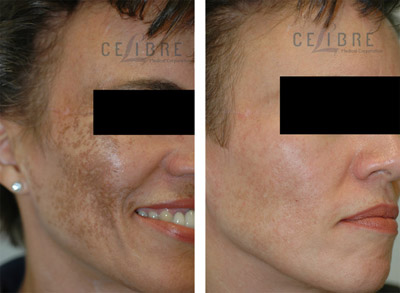 One study commonly cited as evidence for the link between hydroquinone and cancer was based upon oral ingestion of hydroquinone in lab rats and mice. Although there is value in extrapolating information from research such as this, it was recognized that the studies were lacking and are now considered outdated.
One study commonly cited as evidence for the link between hydroquinone and cancer was based upon oral ingestion of hydroquinone in lab rats and mice. Although there is value in extrapolating information from research such as this, it was recognized that the studies were lacking and are now considered outdated.
Further, there are also reports of hydroquinone use and darkening of the skin – a condition referred to as ochronosis. Although possibly underreported, ochronosis cases are very rare and associated with sun exposure, and prolonged use at high concentrations. The FDA has called for more current and inclusive studies that focus on the dermal application (on the skin vs oral) of hydroquinone to determine its effect on humans. The FDA’s position is that hydroquinone is generally safe and effective.
Currently, HQ is available without a prescription in numerous over-the-counter products at a 2% concentration. Typically, 4% is what most physicians prescribe and is also found in Obagi and other name-brand products. Anything above 2% is considered a prescriptive product and requires a prior exam by the physician, Nurse Practitioner, or Physician Assistant. This fact is important because consumers routinely purchase these products online or even at Medical Spas without going through the required prescription exam. Those practices dispensing or selling anything above 2% HQ without the required medical exam are breaking the law.
The potential adverse side effects of HQ are directly related to improper use of the product. Rather than the percentage of HQ, the more concerning factor is prolonged and uninterrupted usage of the product. For example, consumers often purchase numerous HQ products for use simultaneously. Without proper supervision and instruction, consumers expose themselves to risk by using low percentages of HQ for an extended period of time. Continuous use is where the risk lies.
At Celibre, our position is clear: hydroquinone is safe and effective when used appropriately.
Appropriate use of Hydroquinone:
Because hyperpigmentation (ex: brown discoloration) can be distressing for our patients, the topical HQ program is an excellent option.
It’s not unusual for patients, both men, to voice concern about their motivation for seeking out aesthetic treatments.
Some curious men will ask, “Do many men get these treatments?” Women, on the other hand, will say, “No one knows that I do these treatments. I’m treating myself today.” A more recent question that I’m asked by patients when receiving their injection treatments is, “do you think I’m being vain?
 I always pause before answering that sincere question. I recognize that the average patient works hard to invest in botox treatments, and I’m very aware that they are trusting me with this investment in themselves.
I always pause before answering that sincere question. I recognize that the average patient works hard to invest in botox treatments, and I’m very aware that they are trusting me with this investment in themselves.
My answer remains the same. “No, I do not. Wanting to help your frown lines or freshen up your appearance is no different than getting your hair done or working out to maintain physical health.”
If we give attention to our physical health, maintaining our hair, nails, or wardrobe, then wanting to improve an important asset, our face, fits nicely into that routine.
I recognize that in this day of endless selfies, outrageous aesthetic treatments, and a society that is overwhelmingly promoting self-centeredness, it’s no wonder that a patient would pose that question.
I have often repeated a mantra over the years of, “crazy people do not wonder if they are crazy.” We can translate that to, “narcissists do not wonder if they are narcissistic” and finally….Vain people do not wonder if they are being vain.
You’re browsing Realself and you keep coming across the term “brow shaping”. If you’re thinking this term relates to plucking, tweezing, or waxing the eyebrows, think again! In the aesthetic world, brow shaping refers to techniques and treatments that change the position, lift/arch, and or volume of the eyebrow and the area around it.
Why is this important? Because no other area reveals more information about your age than your eyes. Signs of sun damage, volume loss, and skin laxity show up here first before anywhere else on your face. A skilled aesthetic practitioner knows this and understands the value of using minimally invasive treatments such as Botox Cosmetic and dermal filler injections to correct and reverse these changes.
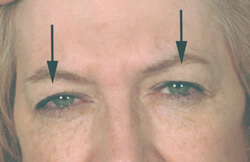
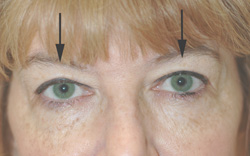 If you feel like your brows are flat, there’s an easy way to both lift and arch them with Botox. When precisely and carefully placed into the right facial muscles, Botox can completely change the shape and position of your eyebrows. Lifting them, opening up your eyes, and smoothing out the skin around the eyes can take years off your appearance.
If you feel like your brows are flat, there’s an easy way to both lift and arch them with Botox. When precisely and carefully placed into the right facial muscles, Botox can completely change the shape and position of your eyebrows. Lifting them, opening up your eyes, and smoothing out the skin around the eyes can take years off your appearance.
If your brow bone (or bony eye socket) has flattened, then injections with dermal filler products such as Juvederm and Restylane can softly and naturally reshape your brow. This in turn also lifts and shapes the eyebrow. Are your eyes looking hollow? Temples sunken in? Do these changes make your eyes look sharp or angular? If so, hyaluronic fillers such as Restylane can safely be used under your eyes and in your temples to add volume, and “round out” your upper face.
Restoring the balance and natural contour of your eyes can help you look refreshed, younger and relaxed. Remember, your eyes are the focal point of your face—your most important facial feature!
Read About All Celibre’s Facial Shaping Techniques
Do you have stubborn areas of fat that won’t go away no matter how much exercise or dieting you do? It is frustrating, and if this sounds like you, then you may have researched potential fat-removing treatments that can help you decrease fat right where you need it.
But what works and what doesn’t? What’s safe and proven and what’s just hype? There are so many choices out there, finding the appropriate treatment that best fits your needs can be an overwhelming challenge!
Here are just a few of the newer technologies that you may have come across in your research: radio frequency, deep dermal tissue heating, laser-assisted liposuction, mesotherapy (injections of fat dissolving substances like Kybella), tissue massage, or different combinations of these.
Here, we’ll discuss one treatment: the VaserLipo System and Vaser HD (Vaser High Def) by Sound Surgical Technologies. The term VASER stands for: Vibration Amplification of Sound Energy at Resonance. The first generation of this technology was introduced back in March 2001. Sound Surgical Technologies then received FDA approval in September 2002 for the third generation of the system. The fundamental concept of VaserLipo is to enhance body contouring by utilizing sound waves.
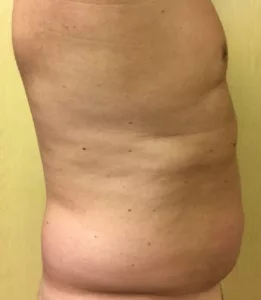
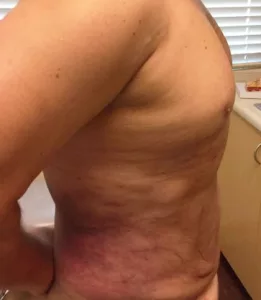
VaserLipo stands out from other traditional fat removal and body contouring treatments as it employs ultrasonic energy (sound waves) instead of laser energy to fragment fat particles. This fragmentation, known as “emulsifying” the fat, reduces the size of the particles, enabling their faster removal through aspiration or suction using conventional methods.
Just how does ultrasonic energy emulsify that fat? Think of it as placing a tuning fork on a bubble: the rapid vibration is no match for the fragile fat cell and it ruptures apart easily. Once broken down into smaller parts, the practitioner or surgeon can then remove the fat cells more quickly and easily.
While the scientific principle underlying VaserLipo is solid, does this mean that it really works to enhance fat removal and translates to better results? Many proponents of VaserLipo say that it does. They claim that the body sculpting and fat-reducing capability is superior to other, similar systems. The reason is, they claim, becuase VaserLipo selectively emulsifies the fat (selective emulsifying) which when combined with improved fluid management, can result in less bruising, less post-procedure swelling and less overall pain after your procedure. All of these factors, they claim, can help you have a speedier recovery after your procedure as well.
To further enhance your results and overall outcome, practitioners often combine VaserLipo with other technologies. For example, some practitioners will use VaserLipo for larger area where you need more fat debulking, and then follow that with SmartLipo (laser-assisted liposuction) in smaller areas. Almost any area on the body can be treated with the VaserLipo system making it very versatile.
There are a few cautionary points for the VaserLipo and VaserHD systems. Remember, these systems rely on three factors: heat, motion and suction, much like traditional liposuction which is the “gold standard” for fat removal. However, the unique factor is the ultrasonic component that these technologies use to emulsify or break down the fat particles. The heat that’s generated can make these systems tricky. In the older generations of these systems, there was inconsistent control over the tissue-heating process. This lead to too many complications following VaserLipo treatment. Although there have been some corrections, the use of these technologies still carries a higher risk of complications compared to traditional liposuction alone. The critics do tend to agree however, that the technology works.
Celibre Medical does not provide VaserLipo, nor do we offer any liposuction treatments at any of our facilities. We simply wanted to share with you our unbiased view of Vaser technology to educate and inform you as you wade through the multitude of information that is out there. We believe we can be a reliable resource for you to look to when seeking information on any cosmetic treatment. Those who achieve the highest satisfaction are the patients who actively seek comprehensive understanding and knowledge of the procedure and treatments prior to proceeding, ensuring they are well-informed about all the intricacies involved.
Again, it’s important to reiterate that these fat-removing treatments are not a substitute for a weight loss program and should never replace the benefits of healthy weight loss through diet and exercise. No matter what technology or procedure you chose, your outcome and satisfaction will rely heavily on the technique and expertise of the provider that you chose for your service. You also need to ensure that you are an appropriate candidate for the procedure. So, do your research and ask lots of questions, and remember that you are your own best advocate.
While it may have a funny, unique-sounding name, melasma is an all-too-common problem. Maybe you or someone you know has it, but you didn’t know it had a name? It causes dark, brown patches most commonly found at the upper cheek, upper lip and forehead. These brown spots come on quickly (during pregnancy, starting birth control, over the summer or after a vacation) can be large and are often symmetrical. Worse, they are almost impossible to cover up with make-up!
Many women are confused about what causes melasma. In truth, we aren’t 100% sure either! But, we know that there are a variety of triggers and that hormonal changes play a major role. Pregnancy (pregnancy mask/chloasma), the use of birth control pills and menopause are common in the onset of the condition. Many patients believe that sun exposure, heat and humidity cause Melasma, but in reality they can make it worse, but not cause it.
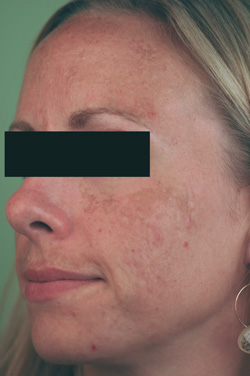
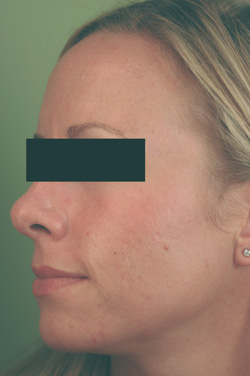
* Melasma before and after photos
Because the exact cause remains unknown, Melasma can be treated but in many cases remains chronic. Often, people who have it struggle over their lifetime with it. Even so, your condition is not hopeless and we can effectively manage this difficult condition!
We understand the frustration and difficulty you’re going through when you have melasma. Chances are you’ve tried many different things to look and feel better, but many aren’t successful. We are here to help you! We can help you understand your condition better, provide an excellent treatment option and explain how to modify your lifestyle to avoid Melasma triggers.
With a good treatment partner, you can have clearer skin and win over melasma! Celibre Medical has helped many women (and a few men) gain control over it and keep it in check. We are confident that we can do the same for you.
It is not uncommon for men and women to confuse sun damage with melasma as both conditions involve pigmentation on the face. Despite the similarities in pigmentation, melasma and sun damage are actually quite different. The source of the discoloration is the major difference between the two melasma and sun damage. For example, melasma is caused by pigmentation (melanocytes) that is generated in response to hormonal fluctuations. Because it is related to hormonal changes (pregnancy, menopause, oral contraceptives, etc.) it is considered chronic and has no cure. The idea behind melasma treatment is to control and suppress the formation of new pigmented cells thereby minimizing the appearance of melasma. One of the challenges in treating melasma is that is can occur in the dermis (deep skin layer). Because the condition can be rooted deep in the skin, the condition can be sometimes be resistant to treatment.
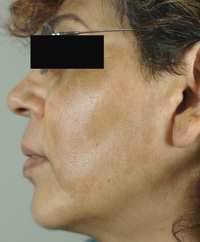
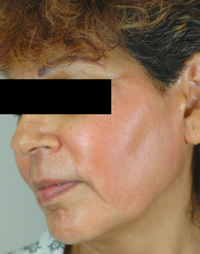
Sun spots and Sun damage laser treatments before and after pictures
In contrast, the pigment associated with sun damage (solar lentigines, seborrheic keratosis, freckles, sun spots, liver spots) lies closer to the surface of the skin and is much less challenging to treat. Existing sun damage is effectively treated with class IV medical lasers whereas melasma may be better addressed with topical preparations. Q-switched (very short pulsed and high powered) laser technology is very effective at breaking down the pigment associated with sun damage in several treatments. This technology also has the benefit of completely destroying the cells associated with the pigment. This means that new cells replace the old ones and do not contain the same pigment that was present previously. With q-switched laser technology, we are able to completely remove most age spots and sun damage.
The following descriptions highlight the differences between melasma and sun damage.
Melasma:
Light to dark brown patches usually seen on the forehead, cheeks, chin, upper lip.
Very symmetrical in appearance on both sides of the face.
Discoloration may be dense pigment and may lie on the epidermis (upper layer of skin), dermis (lower layer of skin), or combination of both.
Linked to hormonal changes and considered a chronic, recurring condition.
Sun exposure, heat and humidity may exacerbate condition.
Sun Damage (Sun Spots, Age Spots, Freckles, etc.):
Appears randomly on all areas of the face.
Usually not symmetrical, may be patchy or scattered.
May be associated with textural changes to the skin also known as photo-damaged skin (lines, wrinkles, etc.)
Not related to hormonal changes but directly linked to sun exposure.
Responds well to lasers.
Not considered a chronic condition.
We know that having melasma can be frustrating, embarrassing and hard to deal with day after day. It’s an extremely common condition yet despite that, we still don’t yet have an effective cure for it. But don’t give up! There are treatments that can control melasma and make it much more manageable! Finding a good practitioner who is experienced and educated about melasma treatment can make all the difference in helping you beat this difficult skin problem.
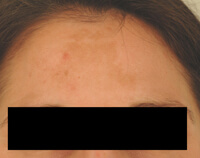
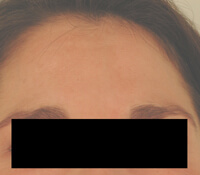 Melasma is a problem with excess pigment. The cells in your skin that make pigment are called melanocytes. In melasma, the melanocytes are overly stimulated to make pigment and this results in the dark patches that pop up on the forehead, cheeks and upper lip. Hormonal stimulation is the culprit that triggers the melanocytes to work overtime. This is what makes melasma so different from and much harder to treat than other conditions that include brown spots like freckles, sun spots, brown acne scars and moles.
Melasma is a problem with excess pigment. The cells in your skin that make pigment are called melanocytes. In melasma, the melanocytes are overly stimulated to make pigment and this results in the dark patches that pop up on the forehead, cheeks and upper lip. Hormonal stimulation is the culprit that triggers the melanocytes to work overtime. This is what makes melasma so different from and much harder to treat than other conditions that include brown spots like freckles, sun spots, brown acne scars and moles.
Treatment for melasma is designed to fade the brown patches and then maintain your clear skin; so, it’s very important to realize that it is an ongoing process. Once you’re better, you need to continue with prescription medication or you will end right back up at square one. The cornerstone of melasma treatment is usually hydroquinone, a bleaching medication that works to suppress excess pigmentation. There is no one mix that works for everyone, so it’s important to be patient, use your product as directed and follow up with your practitioner frequently to assess your response to treatment.
The bottom line to remember with treatment of melasma is that there is hope—and many options for treatment. With patience and diligence, you can and will get better. Hang in there!
Here at Celibre Medical, we offer two, different treatment plans for melasma. We encourage our patients to ask questions and we work hard to make sure that our patients understand their condition. There’s no way to predict which of these two will work for each person, so we let you know this up front and we never make you promises that we can’t keep. We know that successful treatment of melasma depends on an ongoing relationship with you and we’re your partner for the long haul!
Melasma before and after photos
At Celibre Medical, we approach acne from a different perspective. We truly understand how your acne can impact your entire life…not just your skin. We are committed to providing you with the safest, most innovative, and personally tailored acne treatment plans.
Part of this relationship involves straightforward advice and recommendations for ways to manage your acne. Our practitioners have spent years learning and observing what works for the treatment of acne and what doesn’t. Many acne patients come to us extremely confused about what products are “good for” or “safe” to use on their skin. One of the most frequent of these products is mineral makeup.
Infomercials and other forms of direct-to-consumer marketing would have you believe that mineral makeup is an answer (almost a treatment) for acne and acne-prone skin. We believe the opposite. There are many terms that get thrown out there in these marketing ploys: oil-free, safe for sensitive skin, mineral-based, natural, etc. While all these tend to lead you to believe that they are good for acne, they actually aren’t. For a product not to be acne-stimulating, it needs to be labeled non-comedogenic.
Non-comedogenic means that a product doesn’t block or clog pores – which is the first step in the formation of acne. While the mineral makeup manufacturers typically don’t use this term, they use almost everything else to lead you to believe that their products are good for acne. It’s no surprise that most of our acne patients are hesitant to give up mineral makeup. They’ve been falsely led to believe that it’s helping when more than likely, it’s only been adding to their acne problem.
We understand this may be an unpopular opinion. We also can’t prove our position with any formal research or outside verification. This is simply our professional opinion based on years of clinical observation.
We are not against these companies or products at all. But we are against what we believe to be false advertising claims of being “safe” or “helpful” for acne-prone skin. Our years of real-world experience and clinical observations tell us this just isn’t true! We don’t promote one product over another, but we do want our patients to get better. And this means we discuss the use of appropriate skin care products that help us reach this goal, not sabotage it.
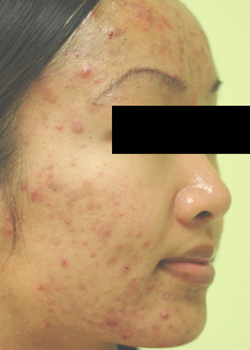
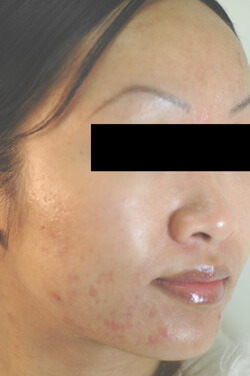
Over the years of treating this common and frustrating condition, we’ve met many women who are dissatisfied with using hydroquinone to treat melasma. Not only have they spent much time and money, they’ve not seen much improvement and feel that it’s only irritated their skin.
We often spend a large amount of time during the consultation discussing this issue. We educate our patients that hydroquinone is a valuable tool in treating melasma, but that it’s only part of a bigger picture.
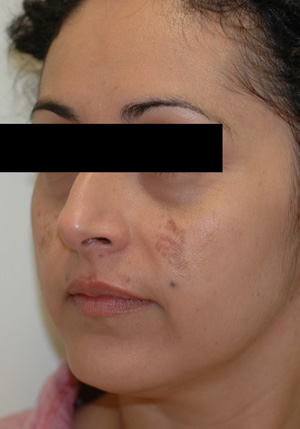
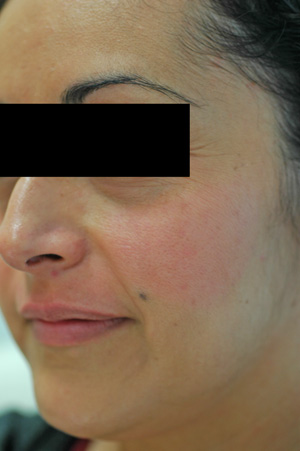
Melasma before and after pictures
That being said, hydroquinone is very useful for melasma, but again, only as one of many treatments that are used in combination. We’ve found that products containing bearberry and kojic acid often augment and enhance the effect of hydroquinone. These are just a couple of complimentary products that we incorporate into a complete, individualized melasma treatment plan.
Finally, we can’t “cure” melasma. However, with the help of our expert nurses, we can tailor a regimen that not only works for you, but that helps your skin look clearer, healthier and more like it did before you developed Melasma.
Have you heard of photodynamic therapy (PDT) for the treatment of acne? Chances are that if you have severe acne or you have failed multiple other conventional acne therapies that you have. ALA stands for aminolevulinic acid, the light sensitizing medication that is used in the treatment. PDT stands for photodynamic therapy, which is the more descriptive of the procedure since it involves both the use of medication and light together to improve your acne.
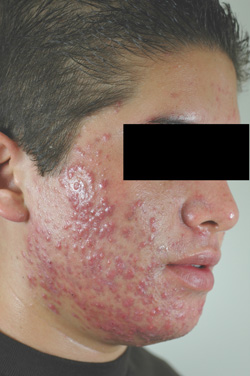
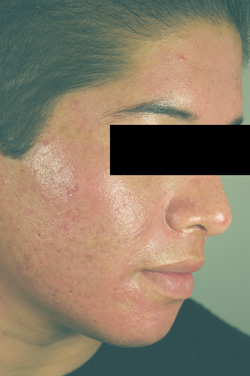
PDT with ALA can be an extremely effective treatment for many skin problems including acne. Many acne patients choose PDT not only because they failed traditional acne treatments, but because they could not tolerate the side effects of powerful acne medications such as Accutane. And while the results for photodynamic therapy can be impressive and many patients do very well after treatment, it’s important to share with you that it is not a treatment without potential side effects.
Post Inflammatory Hyperpigmentation or PIH as it is commonly referred to is the main potential side effect of PDT. We see this side effect in about 20% of our patients, mostly in those with medium or darker skin types (colors). PIH with PDT can happen as a normal response to the intense inflammation triggered by treatment. It can be a persistent red color in lighter skin types, or brown discoloration with medium and dark skin types.
The good news is that it doesn’t last for long. Usually within a few weeks, it resolves on its own. On occasion, we’ve had to use other treatment options to help speed resolution.
Closed comedones or whiteheads can also flare up in response to PDT treatment. We see this commonly in clusters around the mouth and jawline. Although we aren’t totally sure why this happens, it is believed it may be the skin’s response to the healing hair follicles. Hair follicles are joined to an oil/sweat duct which takes up and stores the ALA during the treatment.
Unlike PIH, which is rare, small comedones around the mouth and jaw happens in most of our patients. In fact, we tell them to expect it during their consultation. While it worries most to see an “acne-like” breakout just after an intense treatment for acne, it doesn’t last long. One to two weeks in most cases is the norm and it typically disappears without any special treatments or products.
At Celibre Medical, we routinely use PDT with ALA therapy for the treatment of severe and/or resistant acne and we believe it’s an invaluable procedure. We’ve seen it help hundreds of patients over the years. But it is a procedure that has the potential for some side effects, and we do our best to always discuss this in-detail and up front with anyone considering it.
If you’ve been diagnosed with post inflammatory hyperpigmentation (PIH), or you have a dark mark on the body related to a previous injury, then this page is for you. PIH is a very common condition that differs from other pigmentation problems like melasma and sun spots.
What is Post Inflammatory Hyperpigmentation and What Causes It?
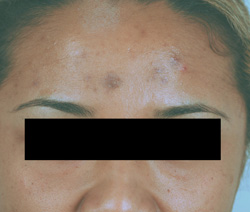
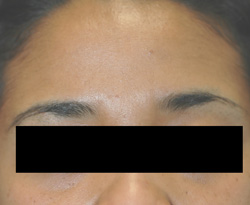
PIH is a temporary darkening of your skin that can happen after an injury (cuts, scrapes, etc.), irritation (acne, rashes, bug bites, etc.), or after a procedure like laser resurfacing. If you’re prone to developing PIH, you probably know it already in that anytime you have ab injury, it turns dark in the area. PIH can also include shades of red and this is mot common in lighter skin types.
While we mentioned that it is temporary, PIH can last anywhere from a few weeks to several months or even a year!
Who Gets Post Inflammatory Hyperpigmentation?
While anyone can develop PIH, it is more common if you have a medium to darker skin type (color).
What Can I Do to Avoid Developing Post Inflammatory Hyperpigmentation?
The short answer is to avoid anything that traumatizes or irritates your skin. This includes harsh or irritating skin care products. You should also avoid anything that produces constant friction on your skin. Don’t pick at acne bumps or insect bites, and make sure that you always wear a good sunscreen.
Another important point to mention is that you should only choose licensed and experienced practitioners to perform any laser or other potentially irritating skin procedures like chemical peels and microdermabrasion on your skin. Ultimately, despite even taking all these precautions, you can still get PIH if you are predisposed to it.
What Treatment Options Do I Have for Post Inflammatory Hyperpigmentation?
PIH is treatable! Many times, your own body can fade the darkened areas over time. But when this natural process just takes too long, there are a few products and treatments that can speed it along. Laser treatments are one safe and effective option that work for many people with PIH. There are lasers that work on the darkest skin type, and often, treatment is completely customizable to your skin and specific needs. In addition, topical medication such as hydroquinone can fade PIH as well. Give us a call to talk more about your dark scars.
When it comes to age spots (sun spots or liver spots), we often pay the price for sun damage that occurred when we were much younger. Research suggests that most of the sun damage to our skin occurs before we get to 18 years old. This sun damage may be present when we are young, but shows up as we age and as our skin thins.
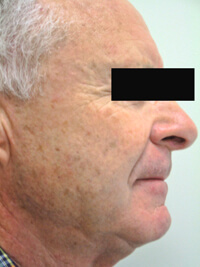
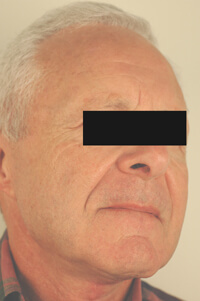 Our skin loses volume as we age and in doing so, it becomes easier to see the sun damage and age spots. The fatty tissue that hid them when we were younger has thinned and the spots rise to the surface where they can be seen easily. Even though this is the case, it’s never too late to start practicing good sun avoidance. A proper sunscreen applied at least once per day goes a long way in preventing future sun spots and sun damage from forming.
Our skin loses volume as we age and in doing so, it becomes easier to see the sun damage and age spots. The fatty tissue that hid them when we were younger has thinned and the spots rise to the surface where they can be seen easily. Even though this is the case, it’s never too late to start practicing good sun avoidance. A proper sunscreen applied at least once per day goes a long way in preventing future sun spots and sun damage from forming.
If you already have sun spots and sun damage, Celibre Medical offers safe and effective laser treatments for all skin types to quickly remove age and sun spots permanently.
To learn more about laser age spot removal, go to www.celibre.com/sun-spots.
To schedule a free laser liver spot removal consultation go to www.celibre.com/contact-list.
To see more laser sun spot removal before and after pictures go to celibre.com/sun-spots-laser-removal-before-after-pictures-photos.
Lori Ishii Haney, RN, MEP-C
Certified Medical Laser Safety Officer

